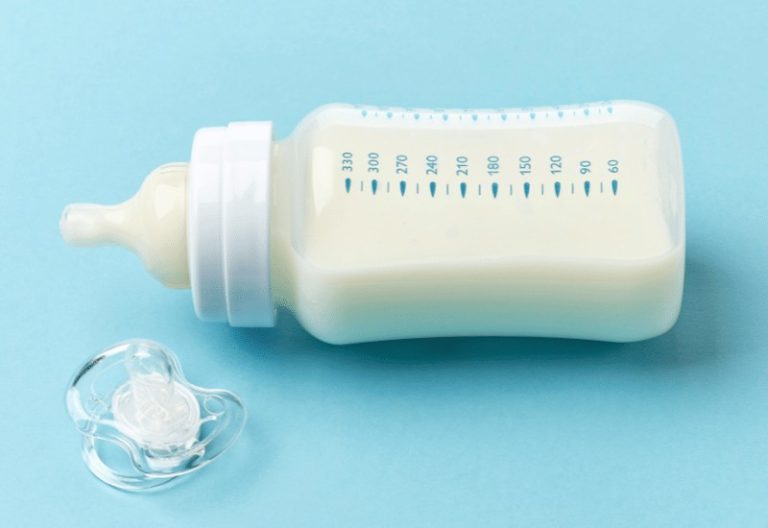A sudden drop in milk supply? Here’s what to do

If you’re breastfeeding or pumping, you’ll likely experience a sudden drop in milk supply at one point or another. Maybe you’re dealing with it now?
There can be many reasons for this, which we’ll take a look at here. And luckily, there’s a lot you can do to get it back to normal.
Let’s dive in.
Read next: Cluster pumping – how to make it a success
This post contains referral links for products I love. Danish Mom earns a small commission at no extra cost to you if you make a purchase through my links. Thank you for your support ♡
Table of Contents
How does breastmilk work?
To avoid getting needlessly technical, breastmilk works on a supply-and-demand basis. Pregnancy triggers the initial supply of milk but, from there, it’s all about supply and demand.
Your baby demands the milk, and your body supplies it. This means that your body will continue to supply breast milk for as long as your baby suckles. Time is no factor.
All of that being said, a sudden drop in milk supply can still happen at any time, and for many different reasons.
If you experience a sudden decrease in milk supply, there are ways of boosting milk supply fast. Before we look into that, let’s examine the reasons why a sudden drop in breast milk supply might happen.
Why does the milk supply drop?
There are many common reasons for a sudden drop in milk supply. Once you know them, you can be vigilant about looking out for and avoiding them. Signs your milk supply is decreasing include:
- A sudden increase in stress levels
- Getting your period
- A decreased amount of nightly sleep
- A change in your diet
All of the above factors can easily contribute to a sudden drop in milk supply. If you’re a new mom and you suddenly experience a growth spurt, even that can cause a sudden drop in milk supply.
Signs that your baby might not be getting enough to eat
If you are concerned that your baby isn’t getting enough to eat, or getting the nutrients they require, there are three key signs to look out for.
Baby is not gaining weight or is losing weight
This is the first sign. If your baby seems to be losing weight, they are not getting the food and nutrients they need. This would strongly indicate a sudden drop in milk supply.
More subtle to notice is the fact that they are not growing and gaining weight in the way that you’d expect.
They may not be losing weight but they’re not growing either. Keep a close eye on this. It’s a strong sign of a low milk supply.
Too few wet diapers
It can be difficult to know how many wet diapers to expect.
But, given how too few wet diapers are a strong sign of low milk supply, here is a handy guide from the Danish Health Authority (link in Danish). A baby should have this many wet diapers per day, according to their age:
- 0-1 months: 8-10 diapers a day
- 1-5 months: 6-9 diapers a day
- 5-9 months: 6-8 diapers a day
- 9-12 months: 6-7 diapers a day
Dehydrated
This ties together with the above sign as well. If you notice that too few wet diapers are being made and that your baby’s urine is a very dark color, they are likely dehydrated.
They may also appear sluggish or drowsy. This is another key sign of a drop in milk supply.
Help for mom: What to do about it
If you suspect a drop in milk supply, and you’re wondering how to increase milk supply, there are quite a few different methods to consider and roads to take.
Here are the most effective ways of addressing and tackling a drop in breast milk supply.
Talk to your doctor or a lactation consultant
This should be your first move.
While there are drinks that increase milk supply, and you can also try acupuncture to increase milk supply (I’ll cover all of these below), visiting your doctor for advice on how to proceed should always be the first thing you do.
From there, you can try things like essential oils to increase milk supply, but see your doctor or lactation consultant first.
Skin-to-skin contact
Skin-to-skin contact between you and your baby is so important, even from a scientific perspective.
According to Mayo Clinic, skin-to-skin contact releases prolactin and stimulates oxytocin which increases milk supply.
Never underestimate the power of physical contact between you and your baby. It does so much good, emotionally and chemically.
Breastfeed during the night
The hormones that stimulate breast milk production are produced in higher quantities during the night. So, a good practice to get into is breastfeeding during the night.
This can really help counteract a drop in breast milk supply.
Try cluster pumping
Cluster pumping (sometimes referred to as power pumping) is a breast pumping technique that can help encourage milk supply.
Over one hour, you pump for ten minutes, take a ten-minute break, then pump for another ten minutes, and repeat until the hour is over.
You should do this once per day and see if it has a positive effect on your breast milk supply.
Read next: Cluster pumping – how to make it a success
Breast pumping
If you don’t use a breast pump at all, consider starting! Simply introducing a breast pump into your daily routine can have a strong effect on your breast milk supply.
Massage and warmth
Avoiding the cold can also have a positive effect on breast milk supply. Keep your body warm and your blood circulating.
You can also try massaging your breasts to stimulate the flow of milk. A mix of warmth and regular massage can work wonders on the supply and flow of breast milk.
Smoothies for breastfeeding
Most of us know that smoothies can work wonders for getting us the nutrients we need. However, there are specific smoothie drinks to increase milk supply.
If you’re interested in mixing up a drink to increase your milk supply, these are the ingredients you need to include in your smoothie: oats, chia seeds, flax seeds, nut butter, leafy greens, sunflower lecithin, brewer’s yeast, and milk dust powder.
These ingredients are some of the best supplements to increase milk supply.
Acupuncture
Acupuncture has been known to increase the supply of breast milk.
It also has other health benefits for a new parent, including reducing anxiety and fatigue. If you’ve never tried it before, consider giving acupuncture a go as a way of increasing your milk supply.
Essential oils
There are quite a few essential oils to boost milk supply, but the three most effective essential oils are fennel, basil, and clary sage.
Using fennel to increase milk supply is a popular technique and one that has been shown to have a positive effect; it’s a fantastic essential oil to increase milk supply. However, you should avoid peppermint.
When using essential oils, use what’s called a carrier oil to dilute the essential oils (coconut oil and almond oil work well).
Apply 1 or 2 of these oils topically on the upper part of the breast 1-2 times daily. After 3 or 4 days you should be up to a good amount of milk.
Nursing tea
Using nursing teas like Organic Mother’s Milk can work wonders when trying to increase milk supply. This particular brand is the best tea for milk supply.
Rest
This one feels like common sense but it cannot be overlooked (especially as a new mom).
The simplest way is often the most effective: Rest when your baby is resting. Ignore housework and laundry; it can wait. What’s more important is that you rest when you get the chance.
This can do wonders for helping with the supply of breast milk.
FAQ – A sudden drop in the milk supply
Why would my milk supply drop suddenly?
A sudden drop in milk supply can be caused by factors such as stress, hormonal changes, a decrease in nursing or pumping frequency, certain medications, or dehydration.
What are the signs your milk is drying up?
Signs your milk supply is drying up include a noticeable decrease in breast fullness, reduced breast milk leakage, and your baby seeming unsatisfied or hungry after feedings.
Additionally, you may experience a reduction in the frequency or amount of milk expressed if pumping.
Can your milk supply come back after decreasing?
Yes, it’s often possible to rebuild or increase your breast milk supply after it decreases.
Key strategies include nursing or pumping more frequently, ensuring proper latch and positioning, staying hydrated, and possibly using galactagogues.
How can I increase my milk supply when it’s dropped?
To increase milk supply after a drop, nurse or pump more frequently, ensure proper latch, stay hydrated, rest as much as possible, and consider lactation-boosting foods or supplements.






